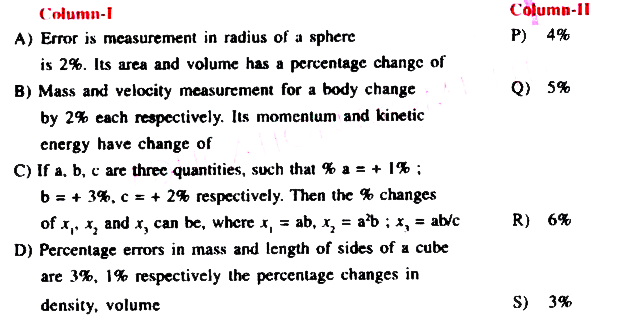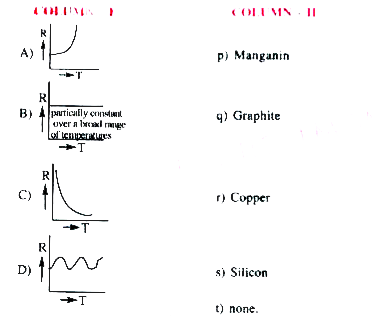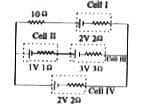In column - I report values of some physical quantities (or) calculations are mentioned and column - II, the number of significant figures are mentioned. Match column - I values appropriately to those mentioned in column - II
The correct Answer is:A-R; B-Q; C-Q; D-P
To solve the problem of matching the values in Column - I with their corresponding number of significant figures in Column - II, we will analyze each option step by step.
Step 1: Analyze Option A - (3.20 + 4.80) x 10^5
- First, we perform the addition:
3.20+4.80=8.00
- The result, 8.00, has 3 significant figures (the trailing zeros are significant).
- The factor 105 does not affect the number of significant figures.
- Therefore, the number of significant figures for this option is 3.
- Thus, A matches with R (3 significant figures).
Step 2: Analyze Option B - 0.030
- In this case, the leading zeros (0.0) are not significant.
- The significant figures are only the digits "3" and "0" after the decimal.
- Therefore, this number has 2 significant figures.
- Thus, B matches with Q (2 significant figures).
Step 3: Analyze Option C - (3.8 x 10^(-6)) + (4.2 x 10^(-5))
- To add these two numbers, we need to express them in the same power of ten. We can convert 4.2x10−5 to 42x10−6.
- Now we can add:
3.8x10−6+42x10−6=(3.8+42)x10−6=45.8x10−6
- The result, 45.8, has 3 significant figures.
- Thus, C matches with P (3 significant figures).
Step 4: Analyze Option D - 3.033
- The number 3.033 has all digits significant.
- Therefore, this number has 4 significant figures.
- Thus, D matches with S (4 significant figures).
Final Matching:
- A → R (3 significant figures)
- B → Q (2 significant figures)
- C → P (3 significant figures)
- D → S (4 significant figures)
Summary of Matches:
- A: R
- B: Q
- C: P
- D: S
- First, we perform the addition:
3.20+4.80=8.00
- The result, 8.00, has 3 significant figures (the trailing zeros are significant).
- The factor 105 does not affect the number of significant figures.
- Therefore, the number of significant figures for this option is 3.
- Thus, A matches with R (3 significant figures).
- In this case, the leading zeros (0.0) are not significant.
- The significant figures are only the digits "3" and "0" after the decimal.
- Therefore, this number has 2 significant figures.
- Thus, B matches with Q (2 significant figures).
- To add these two numbers, we need to express them in the same power of ten. We can convert 4.2x10−5 to 42x10−6.
- Now we can add:
3.8x10−6+42x10−6=(3.8+42)x10−6=45.8x10−6
- The result, 45.8, has 3 significant figures.
- Thus, C matches with P (3 significant figures).
- The number 3.033 has all digits significant.
- Therefore, this number has 4 significant figures.
- Thus, D matches with S (4 significant figures).
- A → R (3 significant figures)
- B → Q (2 significant figures)
- C → P (3 significant figures)
- D → S (4 significant figures)
- A: R
- B: Q
- C: P
- D: S
Similar Questions
In column - I report values of some physical quantities (or) calculations are mentioned and column - II, the number of significant figures are mentioned. Match column - I values appropriately to those mentioned in column - II
Column - IColumn - II(A)(3.20+4.80)×105(P)4(B)0.030(Q)2(C)(3.8×10−6)+(4.2×10−5)(R)3(D)3.033(S)2
View SolutionIn column - I some physical situations are mentioned, in column - II corresponding variations of resultant quantities percentasge errors are mentioned. Match column - I entries appropriately with column - II entries

View Solution
Knowledge Check
Match the column I with column II and mark the appropriate choice.
Column IColumn II(A)Fe(OH)3(i)Ksp=s2(B)Ag2CrO4(ii)Ksp=27s4(C)CH3COOAg(iii)Ksp=108s5(D)Ca3(PO4)(iv)Ksp=4s3A(A)→(iii),(B)→(ii),(C)→(iv),(D)→(i)B(A)→(ii),(B)→(iv),(C)→(i),(D)→(iii)C(A)→(i),(B)→(iii),(C)→(ii),(D)→(iv)D(A)→(iv),(B)→(i),(C)→(iii),(D)→(ii)
Match the following :
Column-IColumn-II(A)3s1(p)n=3(B)3p1(q)l=0(C)4s1(r)l=1(D)4d1(s)m=0(t)m=±1
View SolutionEach figure in Column - I shows the variation of resistance with temperature. Some materials are mentioned in Column - II. Match Column - I with Column - II.

View SolutionThere are four vernier scales, whose observations are given in column - I and the correcponding calculations of least count are given in column - II. Match column - I with column - II appropriately. (Here S = value of IMSD : N = Value of number of divisions on vernier) (Assume ideal conditions)
Column - IColumn - II(A)S=1mm:N=10(P)0.05mm(B)S=0.5mm:N=10(Q)0.01mm(C)S=0.5mm:N=20(R)0.1mm(D)S=1mm:N=100(S)0.025mm
View SolutionMatch the elements given in column (I) with the most appropriate expected values given in column (II)
Column IColumn IIElementElectronegative valuesA.F(p)3.5B.O(q)3.0C.N(r)4.0D.C(s)2.5
View SolutionMatch Column - I with Column - II

PQRS(A)1243(B)2143(C)4132(D)4321
View SolutionMatch column-I and Column-II
Column−IColumn−II(A)SF4(1)Tetrahedral(B)BrF3(2)Pyramidal(C)BrO−3(3)See−saw(D)NH4(4)Bent−T
View SolutionFor the circuit shown in fig. 4 cells are arranged.

In Column-I, the cell number is given while in Column-II, some statements related to cells are given. Match the entries of Column-I with the entries of Column-II.

View Solution
